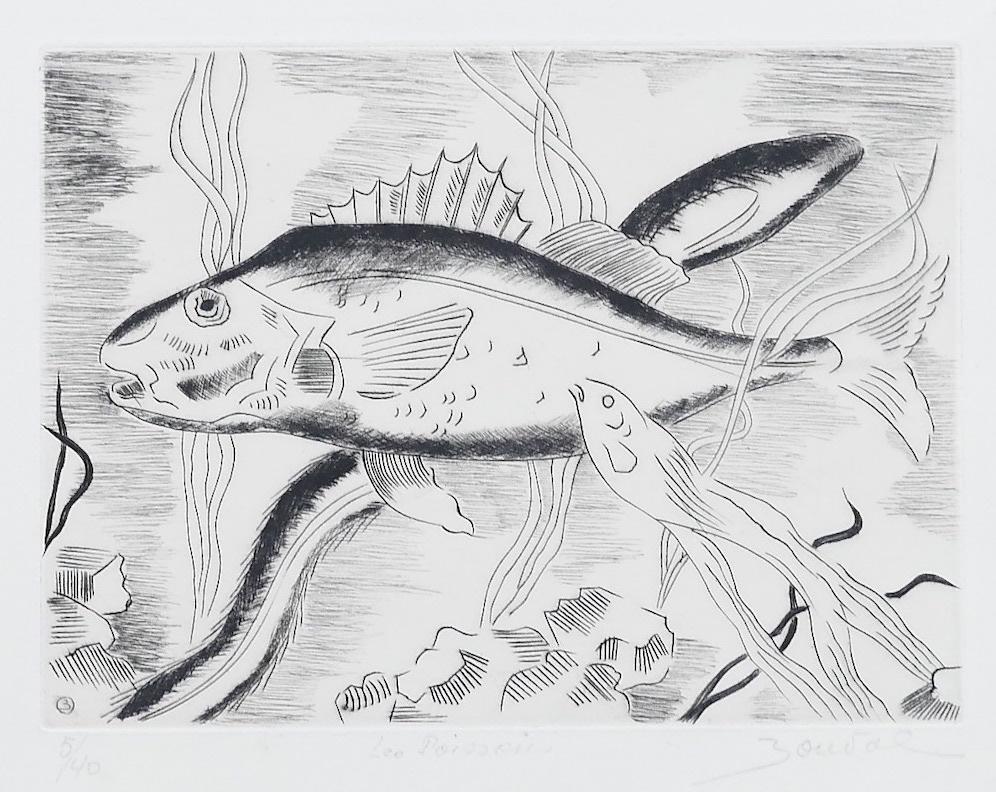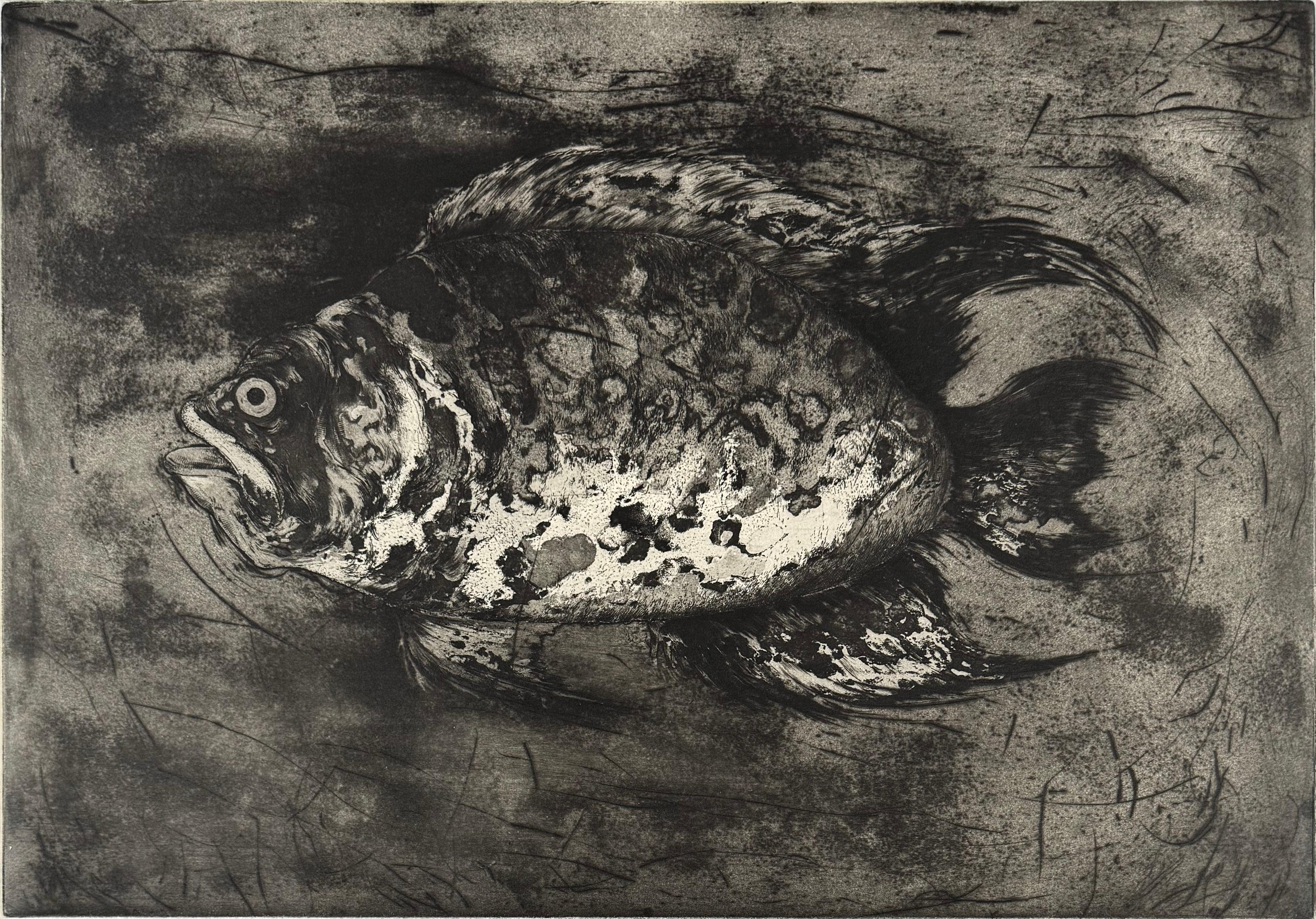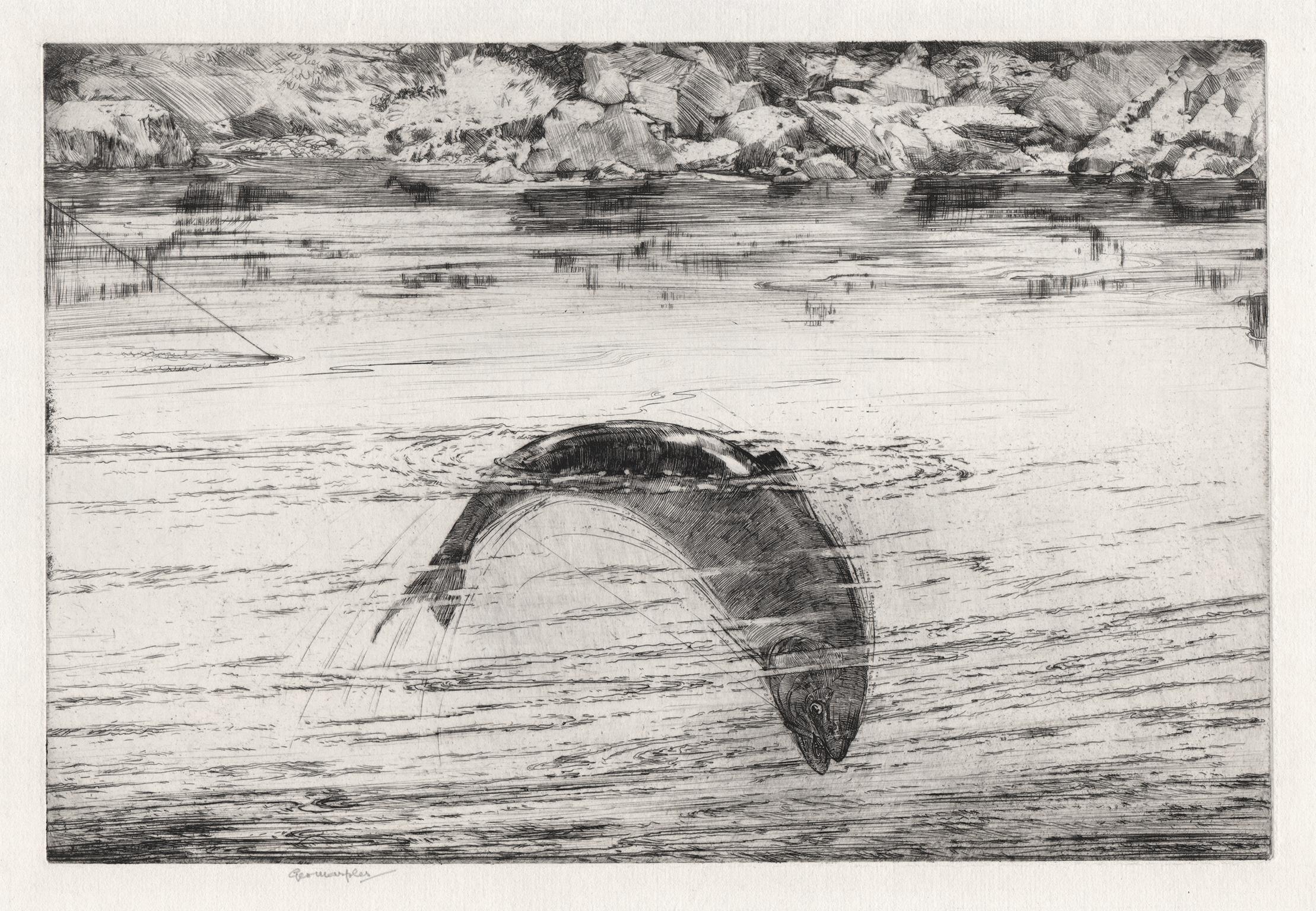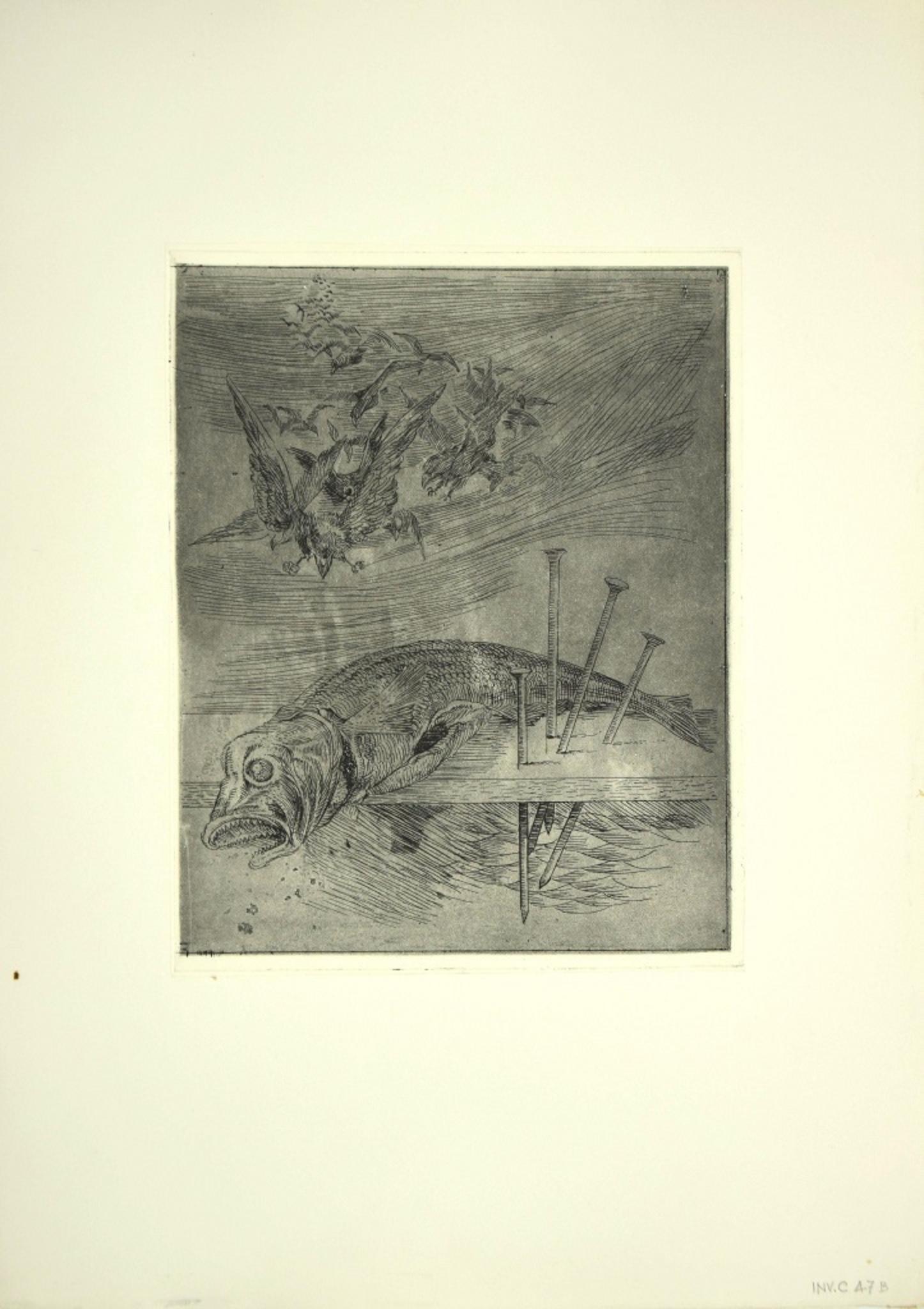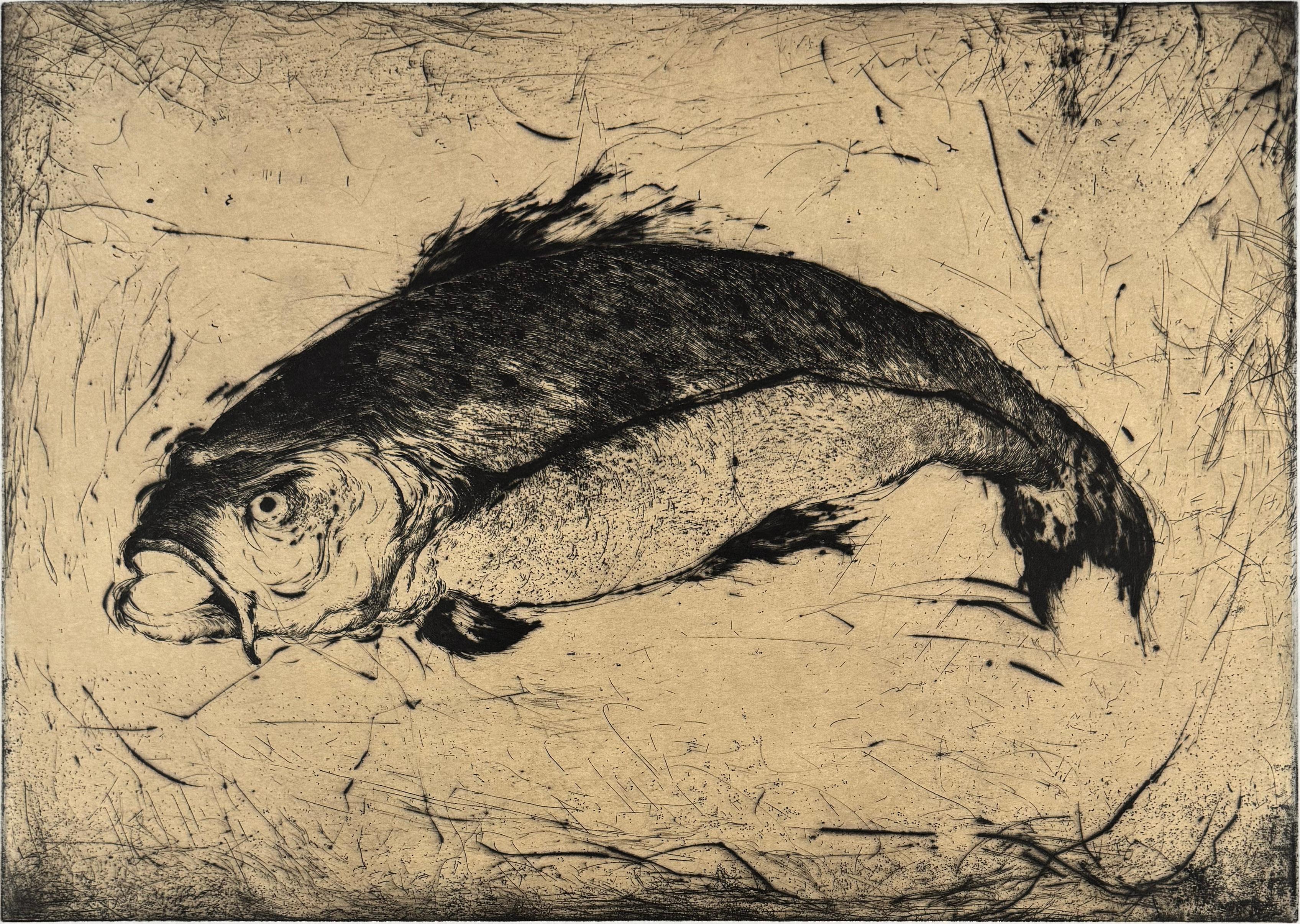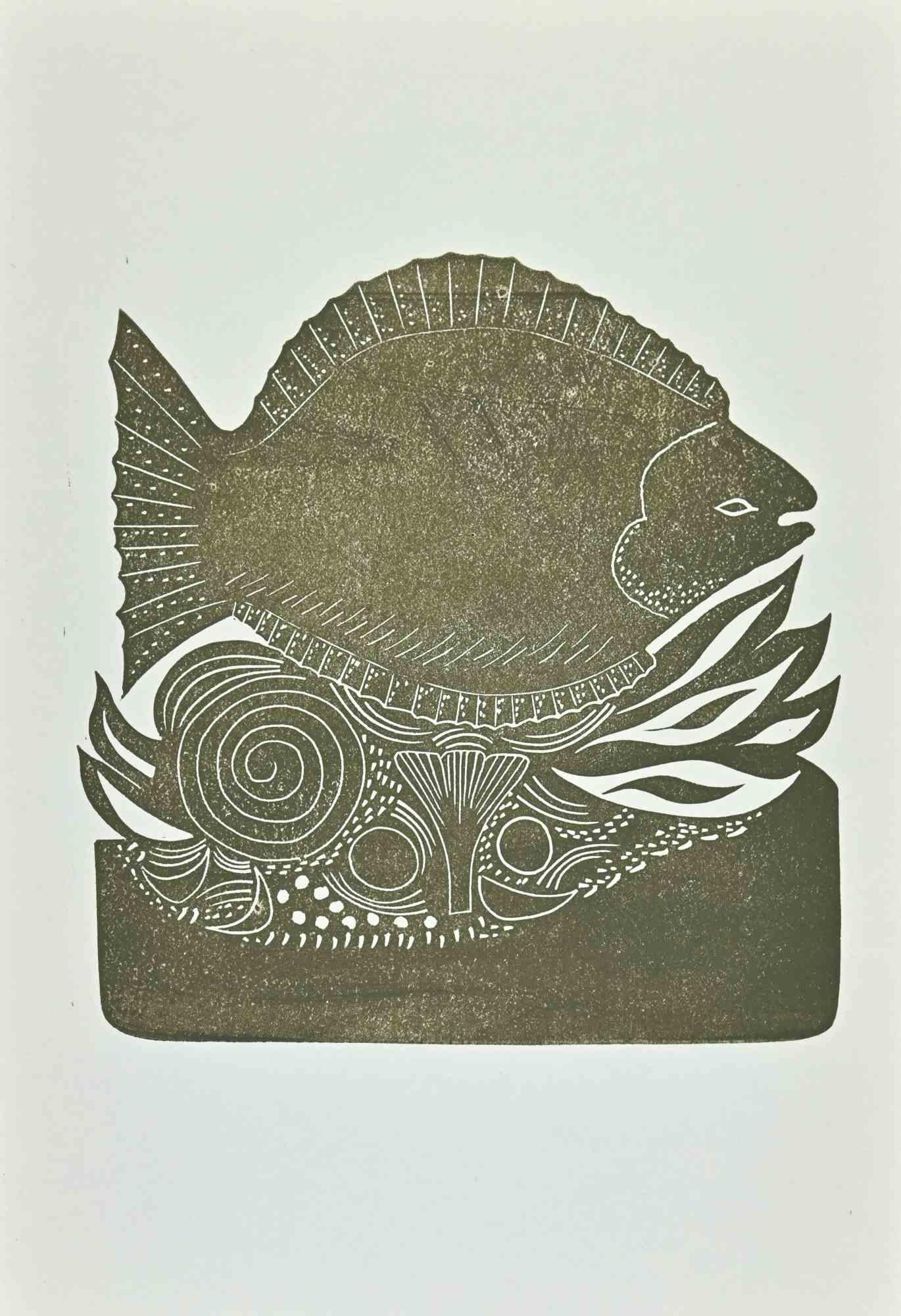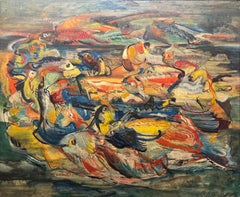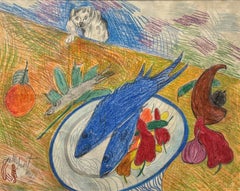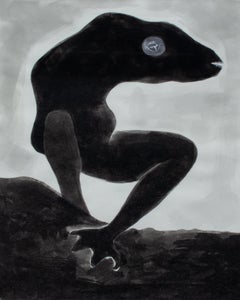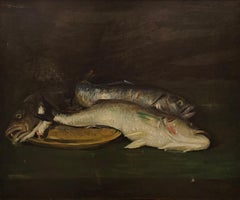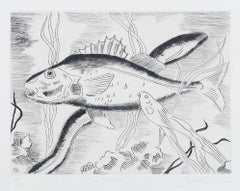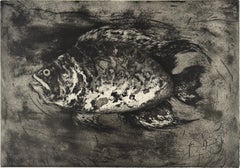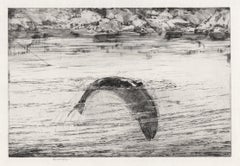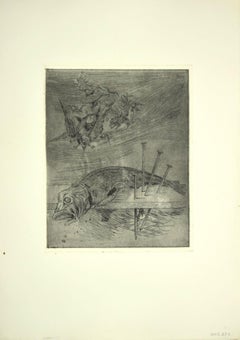Items Similar to "The Fish" Ida Ten Eyck O'Keeffe, Trout, Black and White, Water, Animal Art
Want more images or videos?
Request additional images or videos from the seller
1 of 8
Ida Ten Eyck O'Keeffe"The Fish" Ida Ten Eyck O'Keeffe, Trout, Black and White, Water, Animal Art1935
1935
$7,000
£5,309.05
€6,097.66
CA$10,028.47
A$11,040.60
CHF 5,642.88
MX$131,772.58
NOK 71,845.86
SEK 67,231.71
DKK 45,545.97
About the Item
Ida Ten Eyck O'Keeffe
The Fish, 1935
Signed and dated in pencil lower right
Monotype on paper
Image 6 x 8 1/2 inches
Exhibited
Dallas Museum of Art, Ida O'Keeffe: Escaping Georgia's Shadow, November 18, 2018 - October 14, 2019.
Ida Ten Eck O’Keeffe, Georgia’s artistically talented sister, was unknown to a majority of art enthusiasts until recently. The second daughter of five sisters born to the transient O’Keeffe family in Wisconsin, she received art lessons but after the family’s disastrous financial move to Williamsburg, Virginia, Georgia was the only sibling to receive constant formal schooling. When the family moved to Charlottesville, they converted their home there into an income-producing boarding house, Ida studied education in southwest Virginia, eventually receiving her degree in 1917.
When World War I erupted and after their mother’s death, the sisters spread their wings. Georgia had been introduced to Alfred Stieglitz and his gallery support, so Ida joined Georgia in NYC to study nursing, a smart career move that would see her through difficult years in the Depression. When Ida was drawn into the Stieglitz circle where Georgia was already a prominent member, she spent time at the Stieglitz compound in Lake George, New York during the 1920s and became seriously interested in art. She was wooed by the lascivious Stieglitz, but fell in love with two men in his circle: Paul Rosenfield (1890-1946), an art critic, and later Arnold Rönnebeck (1885-1947), an artist. Neither liaison flourished because Stieglitz’s jealousy undermined Ida’s suitors.
In 1929, Ida entered the Teachers College of Columbia University, a destination for progressive educational curriculum at the time. There, Ida came under the influence of painter Charles James Martin (1886-1955), whose teaching methods emphasized composition inspired by the concepts of Dynamic Symmetry. Ida followed Martin who taught art in Cape Cod’s Provincetown in the summers. Discovering Truro’s nearby Highland Light (house), she adopted it as the subject for her graduate painting requirements. Ida considered the series her artistic breakthrough using Dynamic Symmetry in the same manner of Frank Stella’s and Charles Demuth’s modernist compositions. Ida had begun to exhibit her work at Opportunity Gallery and Delphic Studios in NYC where she received favorable attention.
In 1931 Ida earned a Master’s Degree in Art Education at Columbia, becoming the most educated among her sisters. She received a New Deal commission from the PWAP and also began to create monotypes and other prints. She taught in TN, then at the Valle Crucis School for Girls in northwestern North Carolina. Always linking a personal interest in cultural anthropology to locations where she taught, Ida continued short teaching stints in Alabama, Missouri, New York (receiving summer fellowships at the University of Oregon, etc.) and finally finding a permanent art head position at Lake College in San Antonio, TX. During her peregrine life, Ida and Georgia grew apart as Georgia, supported by then-husband, Stieglitz, informed Ida that there was room for only one successful woman artist in the O’Keeffe family.
Ida’s last teaching job was founding head of the Art Department at Pembroke State College for Indians, in southern NC. However in 1942, Ida took a job with the Douglas Aircraft Company in CA, quit her NC job and soon moved to Whittier, CA. She spent the remaining years of her life in the Quaker city. By 1943 she had purchased a bungalow with a garden not far from the Whittier Art Association and the Woman’s Club where she became active curating exhibitions and showing her own work, mostly from her old inventory including her early lighthouse series. Close to her sisters Anita and Claudia who lived in CA, she remained estranged from Georgia who by then lived in NM. Georgia kept up with Ida through communication with her other sisters but Georgia never invited Ida to visit her iconic NM home as she did her other sisters.
In 1950 Ida’s health began to fail and all the sisters supplemented her modest income. She died in Los Angeles and her remains rest in Forest Hill Cemetery, Madison, WI.
- Creator:Ida Ten Eyck O'Keeffe (1889 - 1961, American)
- Creation Year:1935
- Dimensions:Height: 16 in (40.64 cm)Width: 17 in (43.18 cm)
- More Editions & Sizes:MonotypePrice: $7,000
- Medium:
- Movement & Style:
- Period:
- Condition:
- Gallery Location:New York, NY
- Reference Number:1stDibs: LU1841217078842
About the Seller
5.0
Platinum Seller
Premium sellers with a 4.7+ rating and 24-hour response times
Established in 2022
1stDibs seller since 2022
126 sales on 1stDibs
Typical response time: <1 hour
- ShippingRetrieving quote...Shipping from: New York, NY
- Return Policy
Authenticity Guarantee
In the unlikely event there’s an issue with an item’s authenticity, contact us within 1 year for a full refund. DetailsMoney-Back Guarantee
If your item is not as described, is damaged in transit, or does not arrive, contact us within 7 days for a full refund. Details24-Hour Cancellation
You have a 24-hour grace period in which to reconsider your purchase, with no questions asked.Vetted Professional Sellers
Our world-class sellers must adhere to strict standards for service and quality, maintaining the integrity of our listings.Price-Match Guarantee
If you find that a seller listed the same item for a lower price elsewhere, we’ll match it.Trusted Global Delivery
Our best-in-class carrier network provides specialized shipping options worldwide, including custom delivery.More From This Seller
View All"Piscatory" Abraham P. Hankins, Modernist Composition of Fish, Abstracted Nature
Located in New York, NY
Abraham P. Hankins
Piscatory, 1941
Signed and dated lower center
Tempera on panel
24 x 30 inches
Provenance
Private Collection, New York
Alexandra Avlonitis, New York (acquired from...
Category
1940s American Modern Animal Paintings
Materials
Tempera, Panel
"Fish and Cat" Jimmy Tsutomu Mirikitani, Vibrant, Colorful, Japanese-American
Located in New York, NY
Jimmy Tsutomu Mirikitani
Fish and Cat, 1998
Signed and dated lower left
Crayon on paper
Sight 17 x 23 inches
When Jimmy Tsutomu Mirikitani, a native of California, returned to the ...
Category
1990s American Modern Animal Drawings and Watercolors
Materials
Paper, Crayon
"Cronus Waiting" David Hare, Black and White Surrealist Composition
By David Hare
Located in New York, NY
David Hare
Cronus Waiting, 1990
Ink and Wash on Paper on Board
34 x 25 1/4 inches
“Freedom is what we want,” David Hare boldly stated in 1965, but then he added the caveat, “and what we are most afraid of.” No one could accuse David Hare of possessing such fear. Blithely unconcerned with the critics’ judgments, Hare flitted through most of the major art developments of the mid-twentieth century in the United States. He changed mediums several times; just when his fame as a sculptor had reached its apogee about 1960, he switched over to painting. Yet he remained attached to surrealism long after it had fallen out of official favor. “I can’t change what I do in order to fit what would make me popular,” he said. “Not because of moral reasons, but just because I can’t do it; I’m not interested in it.”
Hare was born in New York City in 1917; his family was both wealthy and familiar with the world of modern art. Meredith (1870-1932), his father, was a prominent corporate attorney. His mother, Elizabeth Sage Goodwin (1878-1948) was an art collector, a financial backer of the 1913 Armory Show, and a friend of artists such as Constantin Brancusi, Walt Kuhn, and Marcel Duchamp.
In the 1920s, the entire family moved to Santa Fe, New Mexico and later to Colorado Springs, in the hope that the change in altitude and climate would help to heal Meredith’s tuberculosis. In Colorado Springs, Elizabeth founded the Fountain Valley School where David attended high school after his father died in 1932. In the western United States, Hare developed a fascination for kachina dolls and other aspects of Native American culture that would become a recurring source of inspiration in his career.
After high school, Hare briefly attended Bard College (1936-37) in Annandale-on-Hudson. At a loss as to what to do next, he parlayed his mother’s contacts into opening a commercial photography studio and began dabbling in color photography, still a rarity at the time [Kodachrome was introduced in 1935]. At age 22, Hare had his first solo exhibition at Walker Gallery in New York City; his 30 color photographs included one of President Franklin Roosevelt.
As a photographer, Hare experimented with an automatist technique called “heatage” (or “melted negatives”) in which he heated the negative in order to distort the image. Hare described them as “antagonisms of matter.” The final products were usually abstractions tending towards surrealism and similar to processes used by Man Ray, Raoul Ubac, and Wolfgang Paalen.
In 1940, Hare moved to Roxbury, CT, where he fraternized with neighboring artists such as Alexander Calder and Arshile Gorky, as well as Yves Tanguy who was married to Hare’s cousin Kay Sage, and the art dealer Julian Levy. The same year, Hare received a commission from the American Museum of Natural History to document the Pueblo Indians. He traveled to Santa Fe and, for several months, he took portrait photographs of members of the Hopi, Navajo, and Zuni tribes that were published in book form in 1941.
World War II turned Hare’s life upside down. He became a conduit in the exchange of artistic and intellectual ideas between U.S. artists and the surrealist émigrés fleeing Europe. In 1942, Hare befriended Andre Breton, the principal theorist of surrealism. When Breton wanted to publish a magazine to promote the movement in the United States, he could not serve as an editor because he was a foreign national. Instead, Breton selected Hare to edit the journal, entitled VVV [shorth for “Victory, Victory, Victory”], which ran for four issues (the second and third issues were printed as a single volume) from June 1942 to February 1944. Each edition of VVV focused on “poetry, plastic arts, anthropology, sociology, (and) psychology,” and was extensively illustrated by surrealist artists including Giorgio de Chirico, Roberto Matta, and Yves Tanguy; Max Ernst and Marcel Duchamp served as editorial advisors.
At the suggestion of Jacqueline Lamba...
Category
1990s Abstract Mixed Media
Materials
Paper, Ink, Board
"Still Life of Fish" William Merritt Chase, American Impressionist Bravura
By William Merritt Chase
Located in New York, NY
William Merritt Chase
Still Life of Fish
Signed lower right
Oil on canvas
32 x 39 1/2 inches
Provenance
Francis E. Myers, III, Ashland, Ohio
Butler Institute of American Art, Youngs...
Category
Early 1900s American Impressionist Still-life Paintings
Materials
Canvas, Oil
"Untitled" Paul Resika, Modernist, Black and White, Abstracted Composition
By Paul Resika
Located in New York, NY
Paul Resika
Untitled
Signed lower right
Etching on wove paper
10 1/2 x 6 inches
Paul Resika (born 1928, New York, New York) is primarily recognized for his artwork featuring the di...
Category
1990s American Modern Figurative Prints
Materials
Paper, Etching
"Untitled" Calvert Coggeshall, Abstract Expressionism, Black, Grey, and White
Located in New York, NY
Calvert Coggeshall
Untitled, 1958
Oil on Canvas
38 H. x 36 W. inches
Provenance:
The artist's estate
Calvert Coggeshall worked as an abstract painter and interior designer primarily in Maine and New York City. From 1951 to 1978, he exhibited regularly with the Betty Parsons Gallery, and later with its successor, the Jack Tilton Gallery.
Born in Whitesboro, New York, Coggeshall started his career as an interior designer, working on commissions for clients in the New York City area. He later consulted on the interior designs for Henry Dreyfuss' line of cruise/cargo ships called American Export, popular from the 1940s through the 1960s. In the 1940s, he also worked with inventor Arthur Young to design interiors for the first full-sized scale of Bell helicopter models...
Category
1950s Abstract Abstract Paintings
Materials
Canvas, Oil
You May Also Like
Fish - Original Etching by Maurice Bouval - 1960s
Located in Roma, IT
Fish is original etching on paper, realized by the French artist Maurice Bouval (1863–1916).
Hand-signed on the lower right and numbered on the lower l...
Category
1960s Modern Figurative Prints
Materials
Etching
Poisson #5, etching of a fish by Marjan Seyedin
Located in Palm Springs, CA
One of 6 prints of fish created by Franco-Iranian artist Marjan Seyedin. In her works, birds and animals provide an allegorical representation for mankind. Marjan has a contemporary...
Category
2010s Contemporary Animal Prints
Materials
Etching
Hooked Salmon, angling fish etching by George Marples, circa 1920
Located in Melbourne, Victoria
Marples was a painter, etcher, writer on ornithology, and principal of Huddersfield, Hull and Liverpool School of Art. He specialized in etchings of fish...
Category
1920s Other Art Style Animal Prints
Materials
Etching, Drypoint
Fish - Original Etching by Leo Guida - 1970s
By Leo Guida
Located in Roma, IT
Fish is an original Contemporary artwork realized in Italy in the 1970s by the italian artist Leo Guida.
Etching on paper.
Not signed.
Mint conditions.
Leo Guida. Sensitive to c...
Category
1970s Contemporary Animal Prints
Materials
Etching
Poisson #1, etching of a fish by Marjan Seyedin
Located in Palm Springs, CA
One of 6 prints of fish created by Franco-Iranian artist Marjan Seyedin. In her works, birds and animals provide an allegorical representation for mankind. Marjan has a contemporary...
Category
2010s Contemporary Animal Prints
Materials
Etching
Fish - Original Lithograph By Jean Lurçat - Mid-20th Century
By Jean Lurçat
Located in Roma, IT
Fish is an original artwork realized by the french artist Jean Lurçat (1892 Bruyeres - 1966 St.-Paul-de-Vence)
Lithograph print, mid-20th century.
Very good conditions. Not sign...
Category
Mid-20th Century Modern Figurative Prints
Materials
Lithograph
